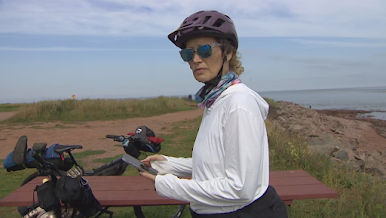A business model that relied on dealers
When OxyContin (oxy) was first released in 1996, it was marketed as a wonder drug: a powerful, non-addictive painkiller. Its manufacturer, Purdue Pharma, and the distributors began an aggressive campaign to sell the drug.
Doctors and pharmacies were pushed hard to prescribe and dispense OxyContin for any pain — from major surgery to a sprained ankle. In the film, Papantonio describes the main message as ''Hey, we've got this wonderful new narcotic that's not addictive."
But as prescriptions increased, more people became hooked. "You're addicted to OxyContin within a two-week time," said Alex Dimattio, a former drug dealer who started selling in 1999.
And as more patients became addicted, the illegal market for oxy grew. In The Oxy Kingpins, Dimattio and another former dealer who goes by "Doug" explain how easy it was to get more pills.
Dealers would take groups of people — strangers, family members, anyone available — to pain clinics and doctor's offices, where a physician would write each person a prescription regardless of their complaint. The dealers then loaded the group into a van and took them to a pharmacy, where the prescriptions would be filled.
"It was crazy. One doctor writing [prescriptions] for 500 [or] 600 pills," Doug recalled. "I mean, enough to kill 10 terminally ill cancer patients — giving it to somebody with a twisted ankle."
Pushing pills and ignoring the obvious
The U.S. Controlled Substances Act requires distributors to monitor how much medication is delivered to retailers. But Carol Moore, an investigator working on the lawsuit, discovered that those checks and balances were ignored as the demand for oxy skyrocketed.
The three largest American drug distributors — McKesson, AmerisourceBergen and Cardinal Health — shipped as much of the drug as pharmacies asked for, making billions of dollars in sales.
Reading from an email thread between two employees, Moore revealed the level of awareness among drug company staff: "'Just got a release today. You will receive 1,200 bottles on Thursday morning.'" And she continued with the reply: "'Keep 'em comin'! Flyin' out of here. It is like people are addicted to these things or something. Oh, wait, people are.'"
Records show that millions of pills were supplied to small towns whose populations couldn't possibly absorb the volume. And distributors seemed to know exactly what was going on.
"They knew that there were people in the field that were illegal distributors," said Papantonio. "When you deliver 12 million pills to a town of 500 people, the criminal is going to get his hands on some of it. You can't run from the fact that you know that.…
"The people who were making the drugs, they understood that this was a cash cow for them. The manufacturers, the distributors, the big-store pharmacies — they're all part of it."
The wrong people were punished
Hundreds of thousands of people have died since the beginning of the opioid epidemic. Families have been torn apart.
The opioid crisis, the film finds, is an epidemic of design: one driven by profit chasing. And Papantonio's lawsuit is an attempt to hold the distributors and manufacturer responsible.
"McKesson: $194 billion in revenues is what they had last year — $194 billion," Papantonio said. "But they don't want to pay their share now to rehab all of these people that they have intentionally addicted. And I say 'intentionally' because I truly mean it."
In July, Papantonio's legal team and collaborating law firms secured a $26-billion settlement with the Big 3 drug distributors and manufacturer Johnson & Johnson, with the caveat that the money will pay for treatment and education programs in affected communities.
In recent years, greater awareness and a push to stop overprescribing OxyContin has not decreased the demand for opioids. Instead, a market for illicit opioids like fentanyl has emerged in North America, leading to a spike in overdose deaths.
As The Oxy Kingpins reveals, thousands of street criminals, including drug dealers and users, have been imprisoned, along with hundreds of doctors and pharmacists.
"Everybody that touched that drug after they finished making it went to jail. But [the distributors] get their money," said Dimattio, the former dealer. "These guys do the same thing I was doing, but they don't call themselves drug dealers. So they don't get the jail time and they don't get everything taken away from them."
In fact, for their roles in the crisis, the pharmaceutical executives were compensated — handsomely. The CEOs of the top 3 distributors made hundreds of millions during their tenure amid the unfolding crisis.
"I mean, at the end of the day, you got to give it to [John H.] Hammergren," Dimattio said of the former CEO of McKesson, the largest distributor of pharmaceuticals in the U.S. "I mean, the guy won.… 700 and something million dollars. I've met some gangsters, and that guy's a f--king gangster."



































